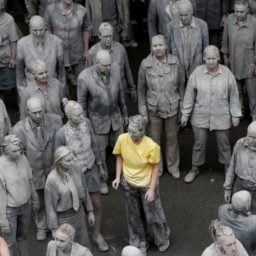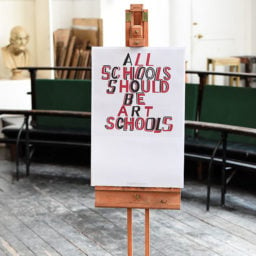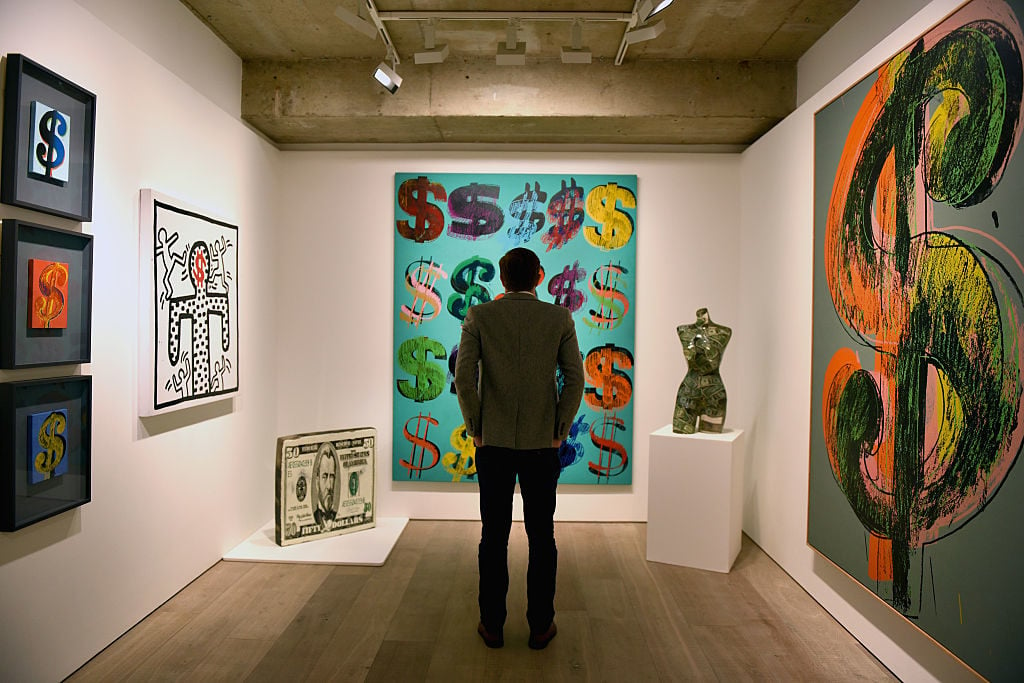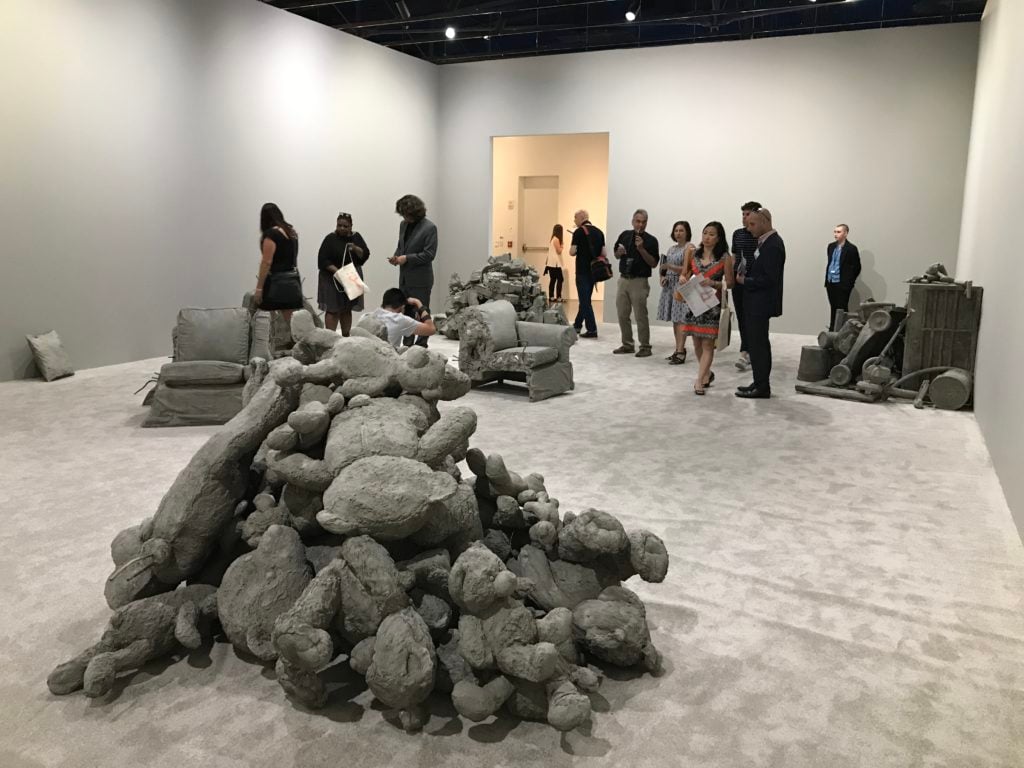Opinion
The Toxic Legacy of Zombie Formalism, Part 1: How an Unhinged Economy Spawned a New World of ‘Debt Aesthetics’
Zombie Formalism may have been the most important movement of the last decade. What did it mean?
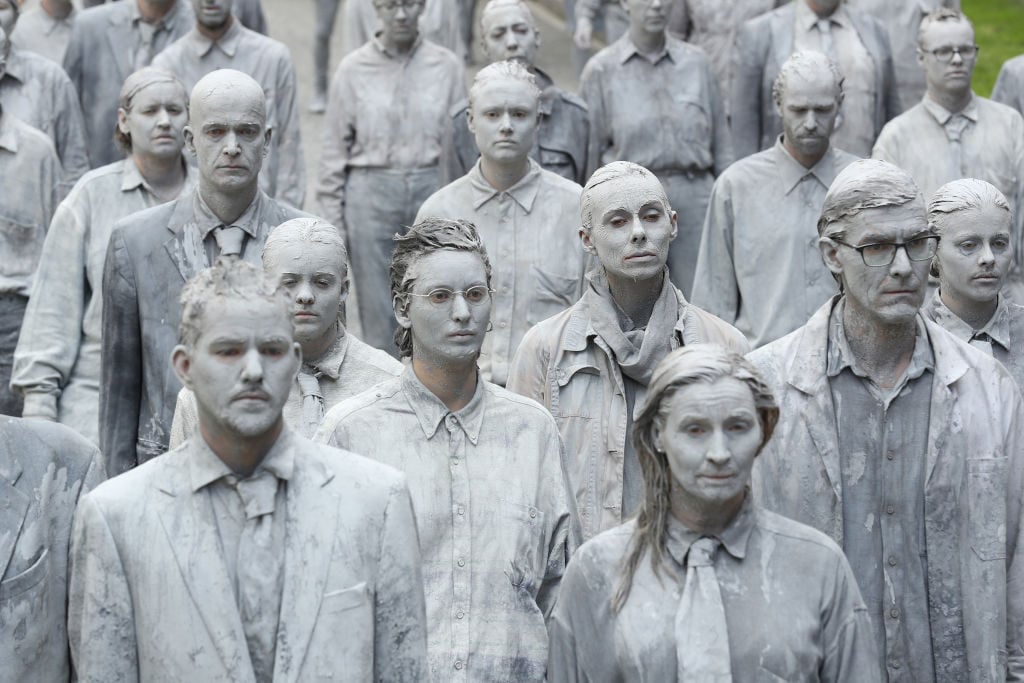
What was Zombie Formalism? If you’re not an avid follower of art-world trends, you may have no idea. Don’t worry: From an aesthetic standpoint, you didn’t miss much. In an economic sense, though, zombie formalism was perhaps the biggest story of the past decade, transforming the art market and changing what it means to be a young artist. It’s a story about art’s fraught relationship to finance, and also, I want to argue, about the way debt has become subtly inextricable from discussions of contemporary aesthetics.
But first: What was it? The artist and critic Walter Robinson coined the phrase in a 2014 piece, “Flipping and the Rise of Zombie Formalism,” addressing the vogue for a certain type of painting among collectors known for their speculative investment in young artists. They’d snap up artworks for relatively low prices and flip the works at auctions soon afterward. The work they favored—by artists like Oscar Murillo, Lucien Smith, and Jacob Kassay—was ubiquitous three or four years ago. And, as the critic Jerry Saltz noted with dismay in a widely circulated essay for New York, a lot of it looked the same.
It was a brand of abstraction that wavered between two poles. On the one hand were paintings whose slapdash creation lent them the look of a painter’s drop cloth, or, as a writer for Bloomberg flippantly noted, a “doodle.” On the other were paintings resembling degraded Minimalist monochromes or Color Field paintings, as if someone had left, say, a Barnett Newman out in the rain.
Unfailingly, these paintings came with alluring creation myths. They were made with fire extinguishers (Smith), or electroplated as if they were mirrors (Kassay), or rubbed with dirt from the studio floor (Murillo). The artist Seth Price, in his excellent novel-cum-polemic Fuck Seth Price, bitingly described these types of works as “tepid compositions, hesitant and minimal in appearance, kind of pretty and kind of whatever, loaded with back story.” They sold for upward of $400,000.
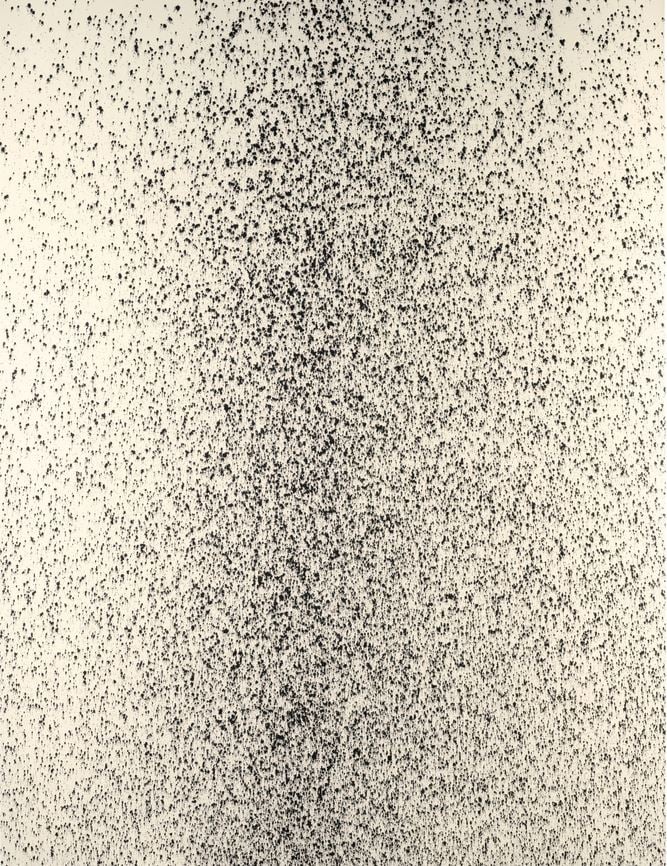
Lucien Smith, Two Sides of the Same Coin (2012), sold at Sotheby’s London in February 2014 for $372,000 against an estimate of $66,000–99,000.
Image courtesy Courtesy of Sotheby’s.
Image courtesy Courtesy of Sotheby’s.
The polite, academic designation for them was “process-based abstract painting,” which is still in occasional use—but it was Robinson’s “Zombie Formalism” moniker, with its built-in critique, that really stuck.
Robinson intended the phrase as an aesthetic jab; it conjures mid-20th century paintings of the sort promoted by Clement Greenberg, slumping through the aisles of art fairs the world over. But others saw in the designation a reflection of the viral nature of the phenomenon, which for a handful of years boasted an alarming rate of infection among both newly minted MFA graduates and the rapacious class of collectors that inevitably trailed along behind them.
By early 2012, it seemed that Zombie Formalism, and the feeding frenzy around it, had altered the fabric of the art world. The reins of aesthetic power, which had for decades traded hands among critics, curators, and various moneyed interests, now belonged solely to the global collector class.
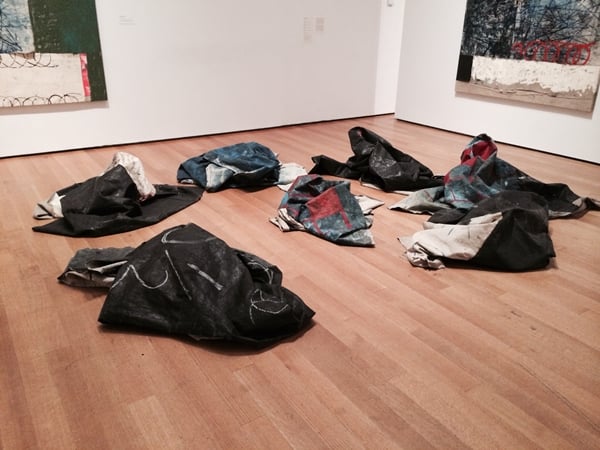
Installation view of Oscar Murillo’s canvases at “The Forever Now: Contemporary Painting in an Atemporal World” in 2014. Photo courtesy of artnet News.
This shift brought no shortage of jeremiads, but the critic David Geers, in his seminal essay “Neo-Modern,” wrote the most enduring takedown of the Zombie Formalists. Comparing “the courtly properties of today’s art” to the frothy Rococo style of 18th-century painters like Fragonard, Nattier, and Boucher, Geers lamented that the work being snatched up by collectors was similarly “limited largely to a propagandistic, affirmative, or decorative role.”
I followed up with Geers via email recently, and he elaborated on this assertion. “My sense of this moment,” he said,
is that [the] splitting of social strata—between the haves and have nots, an alienated and ‘enlightened’ cognoscenti and the ‘rabble’ gathering in the streets—now echoes the social divisions (and art) of the 18th century. Likewise, the model of the artist who can no longer envision or model a future but can only appease the dominant power of the present by aggrandizing a mythical past, seems very reminiscent of epochs that precede the modern era.
Zombie Formalism, in other words, was in this view a new kind of court painting, produced solely to flatter and enrich the titans of the new gilded age. The tail of the market, the critics feared, had begun to wag the dog of art.
***
This is hardly the first time that critics have bemoaned the influence of wealth on aesthetics. If you unspooled the column inches decrying Jeff Koons for pandering to the world’s billionaires, it would stretch, if not from here to the moon, then at least from here to Versailles.
Still, the Zombie Formalism moment was unique: Not only were modern-day courtiers muscling in on an empty aesthetic, they were smuggling truly new levels of astronomical wealth into the market for very, very recent art, too. The money from young collectors flooded in from the fetid financial morass of hedge funds, derivatives trading, deregulation, and corruption. They brought a penchant for speculation and fast profit—and a lack of concern for the potential collateral damage to artists and art.
The pattern began around 2003, when the art market came roaring back from what had been a relatively fallow period. Not coincidentally, this was also a lucrative moment for Wall Street, whose 2003 profits accounted for a whopping 40 percent of US corporate profits overall, up from only 10 percent three decades before. Money appeared to be littered everywhere, giving the search for new financial instruments—and new methods to exploit old ones—a sense of urgency.

Jeff Koons’s Diamond (Blue) is displayed and photographed by onlookers in the plaza, October13, 2007, outside Christie’s in New York. Photo courtesy Don Emmert/AFP/Getty Images.
A flood of capital rushed through galleries, auction houses, and artists’ studios, with an almost exclusive focus on contemporary—and even emerging—art. The money dwarfed that even of the 1980s, when contemporary art became both an investment and a status symbol, and artists like Koons, Jean-Michel Basquiat, and Julian Schnabel achieved megastar status. Now, gallery shows of young artists sold out before their openings, and students at prestigious MFA programs, like Columbia University’s, saw collectors snatching up their work right off the studio walls. Speculation ran rampant. Auction house records were shattered with startling regularity. Everyone—artists and collectors alike—seemed eager to get in on the action.
Finance was turning toward various forms of derivatives—collateralized debt obligations, credit default swaps, mortgage backed securities, etc.—which had the benefit of being loosely regulated, complex to the point of opacity, and hugely profitable. To those weaned in this environment, the art market must have looked quite attractive: It, too, is largely unregulated, with chandelier bidding and price fixing at the major auction houses, plus tax evasion and money laundering among collectors. Its opacity is sacrosanct: The surest sign that a gallery is not serious is that it openly posts its prices. And the potential for profit is nearly limitless, since art is a commodity untethered from objective measures of value.
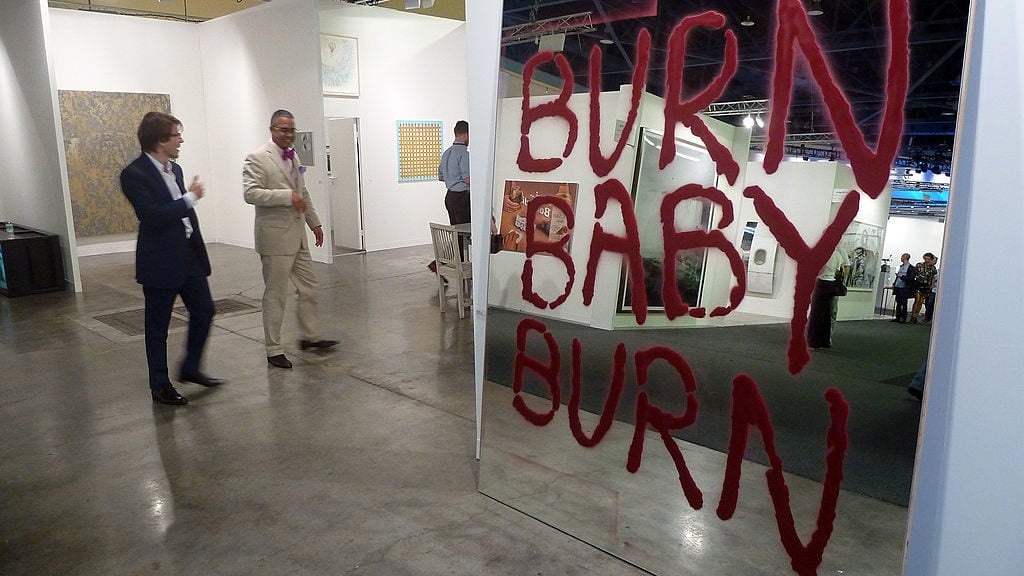
On the ground at Art Basel Miami Beach, 2010. Photo credit Juan Castro Olivera/AFP/Getty Images.
So it was hardly surprising that art got swept up in the financialization whirlwind in the middle of the 2000s. But the real surprise came a few years later, in the wake of the 2008 crash, when the art market managed a rapid recovery that the Financial Times described as “gravity defying.” As investors lost faith in traditional markets, alternative assets like art were increasingly appealing. Aspiring artists, meanwhile, could believe that art had become a viable career option.
***
And so the character of the art flipper emerged onto the scene. Where once collectors had been invested in the long-term maintenance of artists’ careers, flippers were more concerned with near-term profit. Their strategies mirrored the profiteering practices of Wall Street traders, which left taxpayers, mortgage holders, and hopeful retirees holding the bag. But art flippers had an added advantage: the pump-and-dump, a form of stock fraud that’s long been illegal on Wall Street but continues to thrive elsewhere.
If you lived through the 1980s (or saw Martin Scorsese’s The Wolf of Wall Street), you might know the scam: An investor purchases a large amount of low-priced stock and then aggressively promotes it to other buyers, pumping up the stock’s value. When the initial investor calculates that the market has been saturated, he dumps the stock for a tidy profit, crashing it and leaving the other investors in the lurch.
Similarly, certain art flippers have been known to buy up large quantities of a particular artist’s work. They bolster the artist’s reputation through various channels of influence—a popular Instagram account, say, or a network of friends and collectors they advise—only to dump the works at auction after their price inflates.
Unlike stock fraud, such activity in the art market could not possibly be regulated. And anyway, these speculative shenanigans occasionally produce a win-win situation for buyers and artists alike: The rising tide raises all boats. But it doesn’t always work this way.
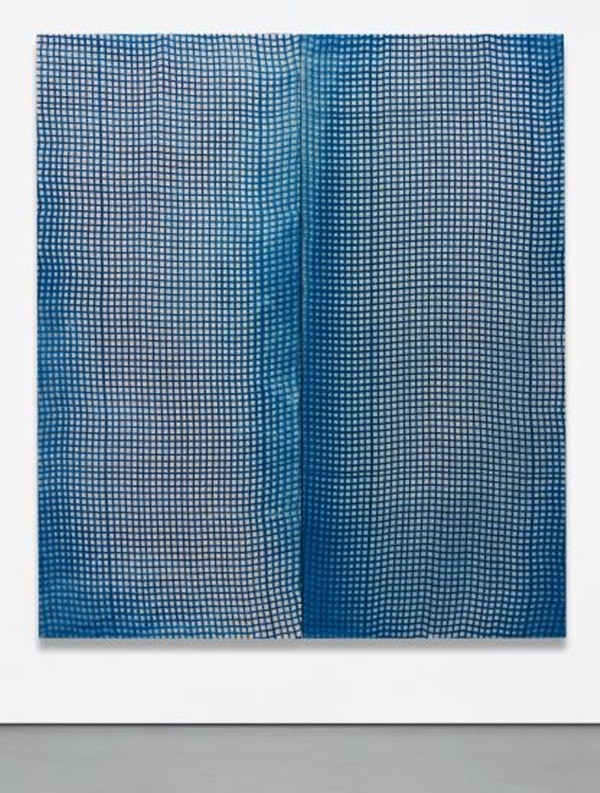
Hugh Scott-Douglas, Untitled (2013). Image courtesy of Phillips.
Last year, Bloomberg published a gem-perfect story about the dealer and collector Niels Kantor, who’d made a desperate attempt to unload a Zombie Formalist-style work by Hugh Scott-Douglas. He bought the work two years ago for $100,000 in the hopes of flipping it for a quick profit. Instead, Kantor was forced to sell it at auction for less than a quarter of what he’d paid for it.
“I feel like we were a little bit drunk and didn’t think of the consequences,” Kantor admitted in the article. “Then the bottom fell out. Everyone got caught with their pants down.”
It’s hard to feel bad for wealthy speculators who take a loss gambling on a risky investment. For most of them, a misstep like Kantor’s means a small percentage drop in their annual art-buying budget. But if you’re an artist, a calamitous drop in prices brought on by speculative noodling can mean an end of your ability to sell art—an end, to some degree, to your career.
Though some artists who experience a surge in speculative interest can ride the wave to something resembling financial comfort, the vast majority of money spent on their work merely flows around them, as if the creators themselves were stones in a stream. Artists, after all, see no money from secondary market sales—those profits go to auction houses and sellers. And an artist jettisoned by the market today will land in a world where the cost of urban living is increasingly prohibitive, and the teaching jobs that once afforded artists a modicum of stability have devolved almost exclusively into poorly paid adjunct positions.
It is also—crucially—a world that has likely saddled them with an exorbitant amount of debt, often in the form of student loans. To enjoy the brief privilege of making other people money, the price is high.
***
For on the other side of the speculative economy is an indebted populace, forced to work increasingly insecure jobs to make ends meet—what some economists call the precariat. They serve as both laborers and instruments, since in addition to whatever valuable work they do, their debt obligations create investment vehicles.

French demonstrators hold a banner reading “For the equality of rights, against a generalized precariat” during a demonstration on May 8, 2017. Photo courtesy Lionel Bonaventure/AFP/Getty Images.
For its part, the contemporary art market is built on artists, the epitome of evanescent, precarious work. Their labor produces investable artworks, but their education is its own kind of locus of speculation and investment: Many artists have accrued substantial debts attending the high-priced MFA programs that are seen as a requirement to secure teaching jobs and launch successful art careers. Debt, particularly student loan debt, plays a vital structural role in the system here.
According to the National Center for Education Statistics, the number of students who received an MFA in the visual and performing arts increased more than 50 percent between 2000 and 2014. In that same period, the cost of tuition at universities nationwide skyrocketed, with the average tuition at private universities increasing by nearly 50 percent as well. Factoring in room and board, students graduating a two-year MFA program in the last six years will have paid approximately $100,000.
And the exorbitant cost of an MFA doesn’t stand alone—it’s layered on top of an undergraduate degree. Unsurprisingly, the costs on that end are high as well. In 2013 the Wall Street Journal concluded that students who graduate from arts-oriented colleges incurred the highest amount of student-loan debt of any undergraduate degree, to the tune of about $21,000 on average. (All this is to say nothing about exorbitant interest rates attached to these loans.)
For all but the wealthiest students, this is a considerable load to take on, especially considering that the earning potential for an MFA graduate isn’t stellar. Payscale, the online salary and compensation information company, ranks the career earning potential for students receiving a masters in studio art 182nd on a list of 189 top master’s degrees. None of these facts are lost on the press, which has produced a stream of articles dissecting the relative costs of high-priced arts training. From artnet News: “Is Getting an MFA Worth the Price?” New York: “An MFA Degree Is Too Expensive, and That’s Only the Start of the Problem.” The Atlantic: “MFAs: An Increasingly Popular, Increasingly Bad Financial Decision.”
One of the most outspoken voices in this ongoing discussion has been the artist, theorist, and educator Coco Fusco, who in recent years has published indictments of the art school system in Modern Painters and the Brooklyn Rail, and organized a daylong conference at the Cooper Union alongside the artist Noah Fischer called “The Artist as Debtor.”
Fusco taught at the MFA program at Columbia University during the art boom of the mid-2000s, when the program had a reputation as a white-hot incubator for future market stars. Over the phone, she told me that art-school students, flush with the optimism bred by an overheated market, had been led to believe that an MFA was a ticket to fame and riches, and many schools are not in the business of disabusing them of that notion.
“You have high-powered schools that charge a lot of money,” Fusco explained, “and the way that they justify charging a lot of money is by offering programs that are supposed to guarantee entry into the marketplace… and that’s supposed to rationalize the debt.” While she was part of the faculty at Columbia, Fusco said, she felt “our job was not to teach, our job was to get [the students] into the marketplace.”
Even at a school with a reputation like Columbia’s, this was a ludicrous proposition. “There are too many MFA programs,” Fusco said. “There are too many students enrolled in MFA programs, and the market will never be able to absorb them.”
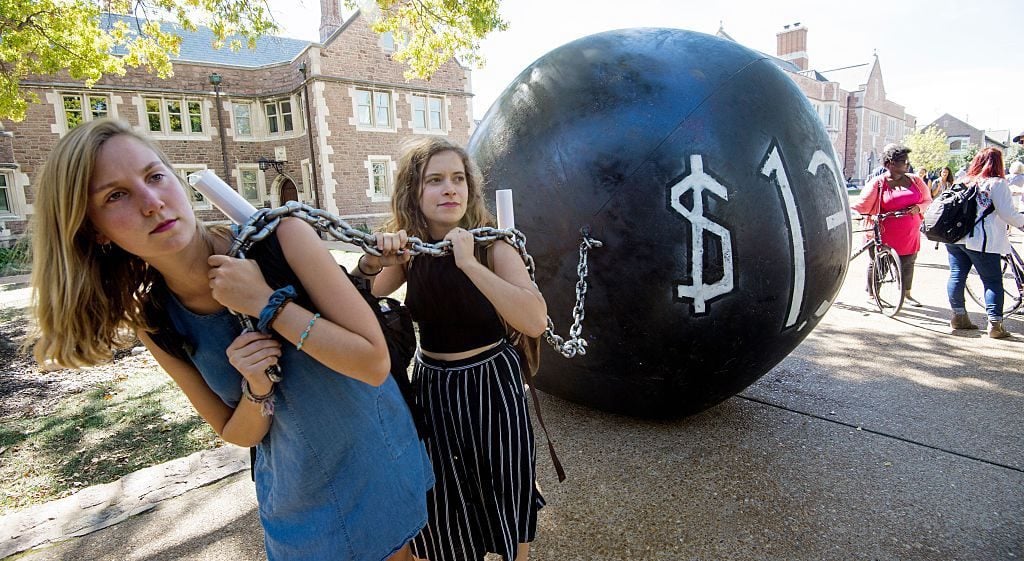
Students pull a mock “ball and chain” representing the $1.4 trilling outstanding student debt outside the second US presidential debate in 2016. Image courtesy Paul J. Richards/AFP/Getty Images.
This is the disappointing truth about dreams: They can’t come true for everyone. And the weight of this truth is measured not just in disappointment, but in debt. “If you are saddled with debt,” Fusco concludes, “then that is going to inhibit your ability to invest time and money in your work. And that means that you may make choices that are market driven. In other words, if you have an opportunity to sell, you’ll direct your production to whatever does sell; it means that you are looking at the market.”
If one half of the Zombie Formalism moment is pure speculation, this is the other. This situation Fusco outlines cannot help but color the entire environment of art and its reception, and thus affect what artists make or dream of making. It is not merely that, as the now-timeworn complaint goes, bohemian or countercultural values have been replaced by a new form of MFA-enabled academicism; it is that the figure of the artist-professional has been further displaced by that of the artist-debtor. Under the sign of debt, the future must meet the needs of a series of predictable, regularized payments. This reality thus favors art that is itself predictable, regularized, and produced in series.
And so, the crystallization of a zombie zeitgeist in the first years of the 21st century’s second decade begins to make sense. It is the result of the feedback loop created between the twin influences of speculation, on the one hand, and debt, on the other. This balance of forces gives the moment its characteristic tone: both knowingly flashy and studiously workmanlike, “kind of pretty and kind of whatever.”
With a nod to the way in which a speculative market has recently had debt as its bedrock, we might think of Zombie Formalism as symptom of this larger and deeper condition: “debt aesthetics.”
What the further implications of this diagnosis are, and what new kinds of engagement it suggests for artists, we will take up in Part II.
Chris Wiley is an artist and art critic living in New York.
Follow artnet News on Facebook:
Want to stay ahead of the art world? Subscribe to our newsletter to get the breaking news, eye-opening interviews, and incisive critical takes that drive the conversation forward.
SHARE

